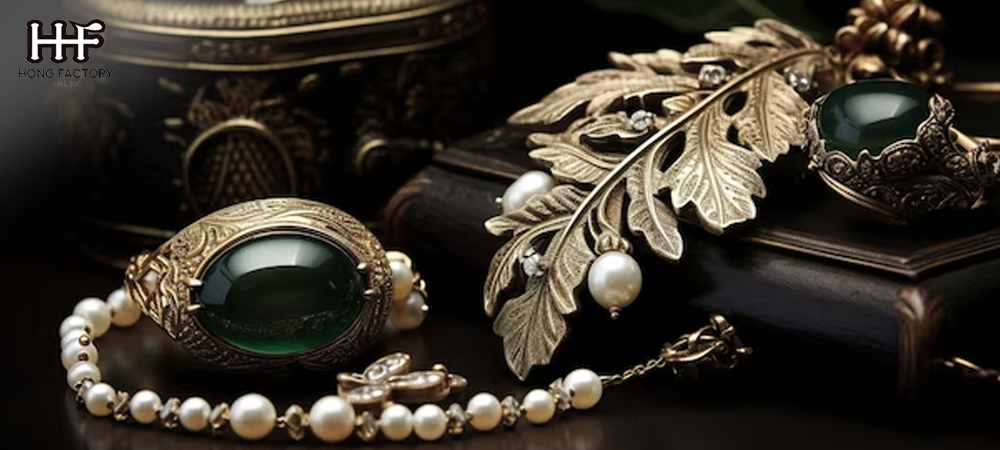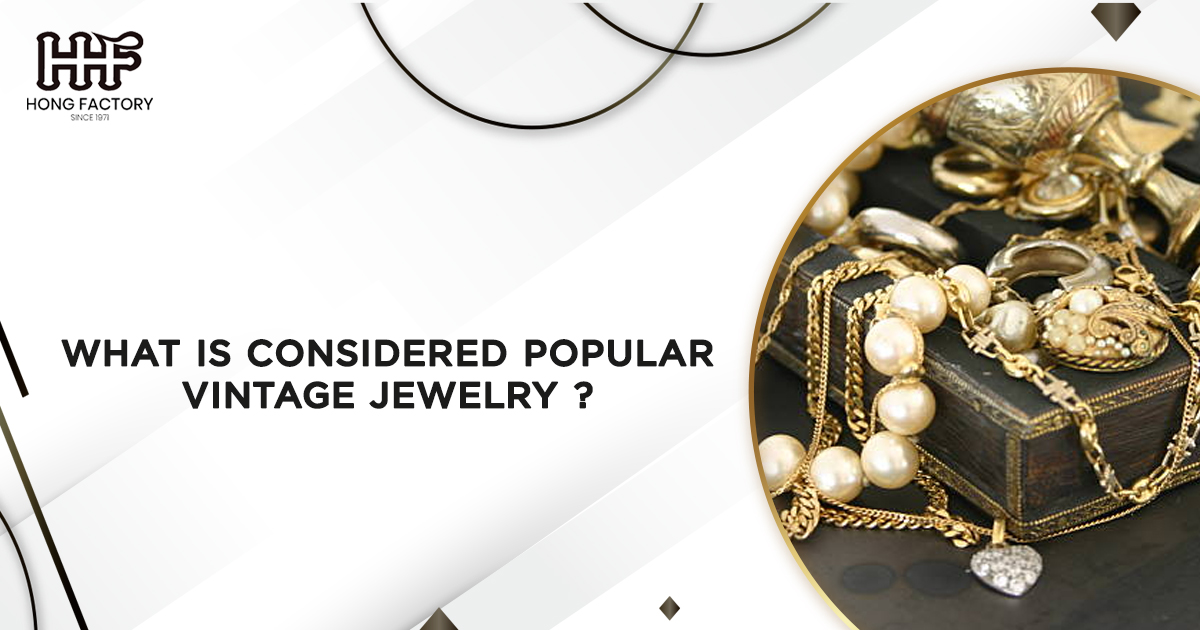Vintage jewelry has always held a special place in the hearts of collectors, fashion enthusiasts, and history buffs alike. These timeless pieces not only offer a glimpse into the past but also provide a unique and stylish way to accessorize. In this article, we will explore what is considered vintage jewelry, delving into various eras, styles, and types of jewelry that have stood the test of time. We will also discuss how to identify and care for these precious items, ensuring they remain cherished for generations to come.
Understanding Vintage Jewelry
Definition of Vintage Jewelry
Before we dive into the specifics, it’s essential to understand what qualifies as vintage jewelry. Generally, vintage jewelry refers to pieces that are at least 20 to 30 years old. This category encompasses a wide range of styles and periods, each with its own distinct characteristics and charm. Unlike antique jewelry, which is typically over 100 years old, vintage jewelry offers a more accessible entry point for collectors and enthusiasts.
The Appeal of Vintage Jewelry
Vintage jewelry is prized for its craftsmanship, unique designs, and historical significance. Each piece tells a story, reflecting the fashion trends, cultural influences, and technological advancements of its time. Additionally, vintage jewelry often features high-quality materials and intricate detailing that are hard to find in contemporary pieces.

Popular Eras of Vintage Jewelry
Art Deco (1920s-1930s)
The Art Deco era is one of the most celebrated periods in jewelry design. Characterized by bold geometric shapes, vibrant colors, and luxurious materials, Art Deco jewelry exudes glamour and sophistication. Popular motifs include sunbursts, zigzags, and stylized floral patterns. Materials such as platinum, diamonds, emeralds, and sapphires were commonly used, often set in intricate, symmetrical designs.
Retro (1940s-1950s)
The Retro era, also known as the Retro Modern period, emerged during and after World War II. This period is marked by bold, oversized designs and a sense of optimism and glamour. Retro jewelry often features large, colorful gemstones, such as aquamarine, citrine, and amethyst, set in yellow or rose gold. Popular motifs include bows, ribbons, and scrolls, reflecting the era’s fascination with Hollywood glamour and femininity.
Mid-Century Modern (1950s-1960s)
Mid-Century Modern jewelry is characterized by clean lines, organic shapes, and a focus on simplicity and functionality. This period saw the rise of Scandinavian design influences, with an emphasis on minimalism and natural materials. Popular pieces from this era include sleek, abstract brooches, statement necklaces, and bold cocktail rings. Materials such as gold, silver, and enamel were commonly used, often paired with semi-precious stones like turquoise and coral.
Bohemian (1970s)
The 1970s brought a wave of bohemian and eclectic styles, reflecting the era’s countercultural movements and free-spirited attitudes. Bohemian jewelry is characterized by its use of natural materials, such as wood, leather, and beads, as well as its incorporation of ethnic and tribal influences. Popular pieces include long, layered necklaces, oversized hoop earrings, and chunky bracelets. This era also saw a resurgence of interest in vintage and antique jewelry, with many people repurposing older pieces to create unique, personalized accessories.
Types of Popular Vintage Jewelry
Rings
Vintage rings are highly sought after for their unique designs and exceptional craftsmanship. Popular styles include
- Art Deco Rings : Featuring geometric shapes, intricate filigree work, and vibrant gemstones.
- Retro Rings : Bold, oversized designs with large, colorful stones set in yellow or rose gold.
- Mid-Century Modern Rings : Sleek, minimalist designs with clean lines and organic shapes.
Necklaces
Vintage necklaces come in a variety of styles, each reflecting the fashion trends of its time. Popular types include
- Chokers : Short, close-fitting necklaces that were particularly popular during the Art Deco and Retro periods.
- Pendant Necklaces : Featuring a single, often elaborate, pendant suspended from a chain. These were popular across various eras, including the Victorian, Art Nouveau, and Mid-Century Modern periods.
- Bib Necklaces : Large, statement pieces that cover a significant portion of the chest. These were especially popular during the 1950s and 1960s.
Bracelets
Vintage bracelets are prized for their intricate designs and high-quality materials. Popular styles include
- Bangle Bracelets : Rigid, circular bracelets that can be worn singly or stacked. These were popular during the Art Deco and Mid-Century Modern periods.
- Charm Bracelets : Featuring a chain with various charms attached, each representing a personal memory or interest. These were particularly popular during the 1950s and 1960s.
- Cuff Bracelets : Wide, open-ended bracelets that can be slipped onto the wrist. These were popular during the Retro and Bohemian periods.
Earrings
Vintage earrings offer a wide range of styles, from delicate studs to bold, statement pieces. Popular types include
- Stud Earrings : Simple, elegant designs that sit close to the earlobe. These were popular across various eras, including the Victorian, Art Deco, and Mid-Century Modern periods.
- Drop Earrings : Featuring a design that dangles below the earlobe. These were particularly popular during the Art Nouveau and Art Deco periods.
- Hoop Earrings : Circular earrings that can range from small and delicate to large and bold. These were especially popular during the 1970s.
Brooches
Brooches are a versatile and stylish accessory that can be worn on clothing, hats, or bags. Popular styles include
- Cameo Brooches : Featuring a carved portrait or scene, often set in a decorative frame. These were particularly popular during the Victorian and Edwardian periods.
- Enamel Brooches : Featuring colorful, glass-like enamel designs. These were popular during the Art Nouveau and Art Deco periods.
- Floral Brooches : Featuring intricate, often three-dimensional, floral designs. These were popular across various eras, including the Victorian, Art Nouveau, and Mid-Century Modern periods.
Identifying Vintage Jewelry
Hallmarks and Maker’s Marks
One of the most reliable ways to identify vintage jewelry is by examining the hallmarks and maker’s marks. These small stamps, usually found on the inside of rings or the back of brooches, can provide valuable information about the piece’s origin, age, and authenticity. Common hallmarks include the metal’s purity (e.g., 14K for gold, 925 for sterling silver) and the maker’s mark, which can often be traced back to a specific jeweler or manufacturer.
Design and Craftsmanship
The design and craftsmanship of a piece can also provide clues about its age and origin. Vintage jewelry often features intricate detailing, high-quality materials, and unique designs that are not commonly found in contemporary pieces. Pay attention to the overall construction, the setting of the stones, and any signs of wear or repair, as these can all provide valuable insights into the piece’s history.
Materials and Gemstones
The materials and gemstones used in vintage jewelry can also help to identify its age and origin. For example, platinum was commonly used in Art Deco jewelry, while yellow and rose gold were popular during the Retro period. Similarly, certain gemstones, such as turquoise and coral, were particularly popular during the Mid-Century Modern period. Understanding the characteristics and trends of different eras can help you to identify and date vintage pieces more accurately.
Caring for Vintage Jewelry
Cleaning and Maintenance
Proper cleaning and maintenance are essential to preserving the beauty and value of vintage jewelry. Here are some tips to keep your pieces in top condition
- Regular Cleaning : Gently clean your jewelry with a soft brush and mild soap solution. Avoid using harsh chemicals or abrasive materials, as these can damage delicate settings and gemstones.
- Professional Cleaning : Have your jewelry professionally cleaned and inspected at least once a year. A jeweler can check for any signs of wear or damage and perform any necessary repairs.
- Proper Storage : Store your jewelry in a cool, dry place, away from direct sunlight and humidity. Use individual pouches or compartments to prevent pieces from scratching or tangling with each other.
Handling and Wearing
When handling and wearing vintage jewelry, it’s important to take extra care to avoid damage. Here are some tips to keep in mind
- Avoid Exposure to Chemicals : Remove your jewelry before using household cleaners, perfumes, or lotions, as these can cause discoloration or damage to the metal and gemstones.
- Be Gentle : Handle your jewelry with care, avoiding any rough or forceful movements that could cause damage to delicate settings or stones.
- Wear with Care : Avoid wearing your jewelry during activities that could cause damage, such as sports or heavy lifting. Additionally, be mindful of any potential snagging or catching on clothing or other objects.
Conclusion
Vintage jewelry offers a unique and stylish way to connect with the past, providing a glimpse into the fashion trends, cultural influences, and craftsmanship of bygone eras. From the bold geometric designs of the Art Deco period to the free-spirited, eclectic styles of the 1970s, vintage jewelry encompasses a wide range of styles and periods, each with its own distinct charm and appeal.
By understanding the characteristics and trends of different eras, as well as how to identify and care for vintage pieces, you can build a collection that not only reflects your personal style but also preserves the beauty and history of these timeless treasures. Whether you’re a seasoned collector or a newcomer to the world of vintage jewelry, there’s no denying the allure and fascination of these exquisite pieces.

